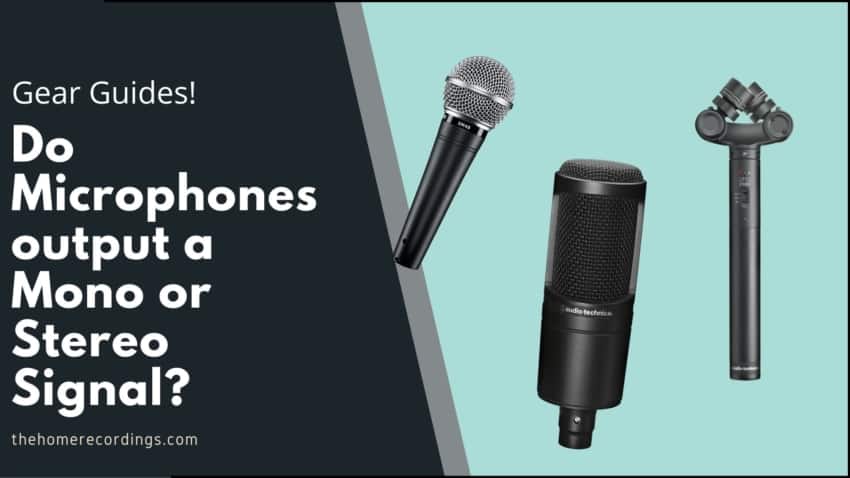Last updated on December 31st, 2023 at 06:03 pm
Microphones are used extensively nowadays, be it in music, podcasts, TV, Radio, etc., and the audio in those types of shows are always in stereo. However, most of the recordings are actually done in mono, especially voices/vocals, which begs the question: Do Microphones output a mono or stereo signal?
In this article, I will explain why microphones only output mono signals and not stereo ones, I will also go over the differences of recording in mono and stereo, what kind of stereo miking techniques there are, the different stereo microphones, and more!
So, without any further ado, let’s get started!
Do Microphones output a Mono or Stereo Signal?
The capsule inside of a microphone converts sound waves into an audio signal. Most microphones have one capsule which outputs a single signal, making them mono devices, while stereo microphones use more than one capsule to output multiple mono signals that can be mixed in stereo.
Essentially, a microphone can output as many different signals as the number of capsules it’s using at the time (activated capsules), and most of these mics allow you to activate and de-activate specific capsules to change the way the microphone works.
For a microphone to be considered stereo it needs to have at least two capsules, however, there are other types of microphones out there that feature multiple capsules and that can capture sound 360-degrees around them (Ambisonic Microphones).
It’s also worth noting that stereo microphones can be used as mono devices if only one capsule is active or if the signals of each of those capsules aren’t panned away from each other. If they are both dead in the center, it could be considered a mono signal as well.
On the other hand, mono microphones are fully capable of recording a stereo image if positioned correctly and if more than one microphone is used (more on miking techniques in a second).
Mono vs Stereo Recording
Most of the times we record in mono, be it in music, podcasts, and even film (when capturing a specific sound source and trying to keep the background noise down) since mono microphones are typically very directional, allowing us to pinpoint the source and to keep other noises out of the recording, such as air conditioners, cars passing by, or any other kind of noise that is not directly in front of the mic.
Stereo microphones, as the name suggests, use two separate capsules to record two tracks of audio, and these capsules are typically in a fixed arrangement (some stereo microphones allow for this to be adjusted), facing to the left and right of the mic, giving you a more natural-sounding recording that better resembles how our ears hear sounds to our left and right.
These microphones are great for capturing the natural ambiance of a space or environment when you do not need to hone in on a single sound source.
This means that stereo recordings end up sounding a lot more “realistic” and provide us with a much more open and immersive experience.
To achieve a great-sounding stereo image you don’t necessarily need to invest in a stereo microphone, since you can use two mono mics and achieve the same results. Here are some stereo miking techniques that you can use:
Stereo Miking techniques
There are many stereo miking techniques out there and they all involve using either more than one mono microphone, or a stereo microphone, to capture the sound and then pan it right and left to create the stereo effect.
I will now go over some of the most used stereo miking techniques out there:
X/Y
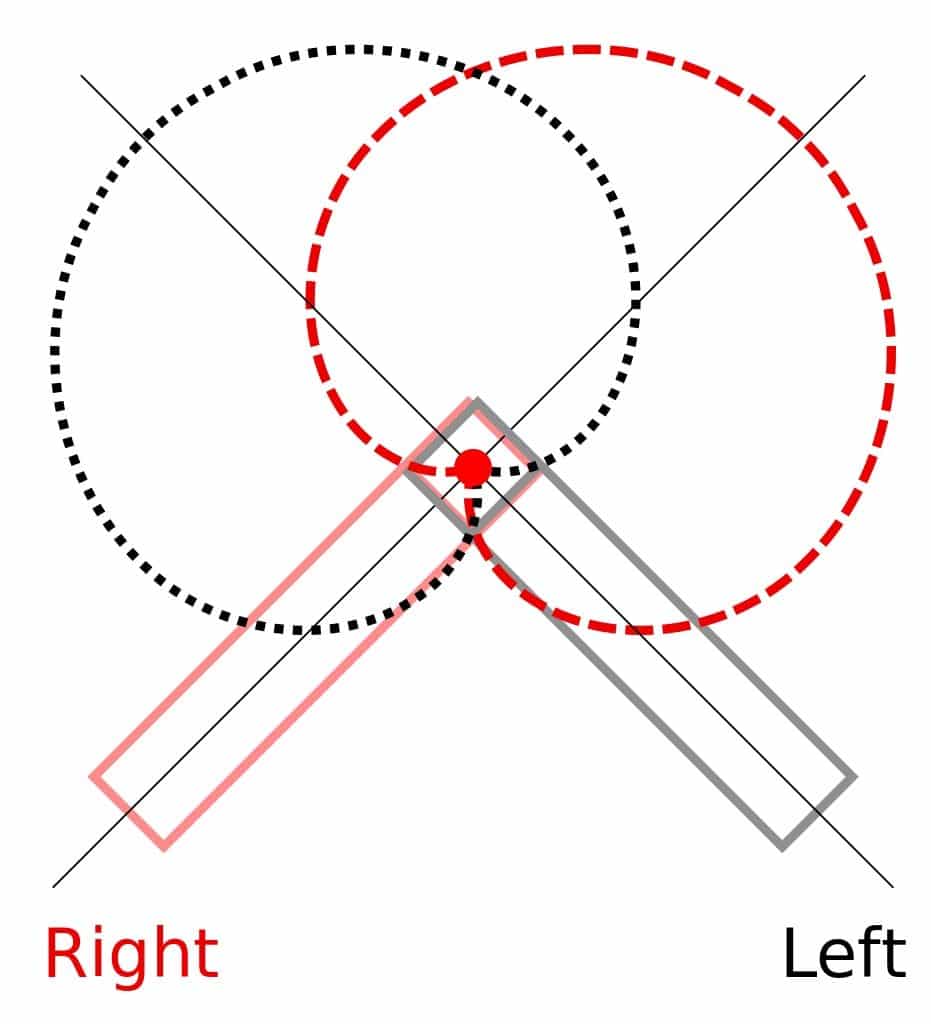
The X/Y miking technique consists of using two cardioid microphones that are setup in a 90° angle with the capsules as close to each other as possible to prevent phase misalignment issues (generally stacked on top of each other).
The sound source is sitting in front in a 45° angle of each microphone (right between the two microphones).
This technique is very often used when recording acoustic guitar, with one mic pointed towards the body of the guitar and the other one towards the fretboard.
The benefit of this method is mainly being able to record in stereo without any phase problems.
Blumlein

The Blumlein Technique involves using two figure-8 microphones which are angled at 90° from each other (Same as X/Y) and with the mic capsules placed as close to each other as possible (generally one on top of the other).
The array is oriented so that the line bisecting the angle between the two microphones points towards the sound source to be recorded (mics angled at 90° with the sound source sitting in the 45°, right in the center between the two mics).
The Blumlein pair produces an exceptionally realistic stereo image, but the quality of recordings is highly dependent on the acoustics of the room and the size of the sound source since this recording setup isn’t as directional, meaning that any background noise will be picked up.
A/B
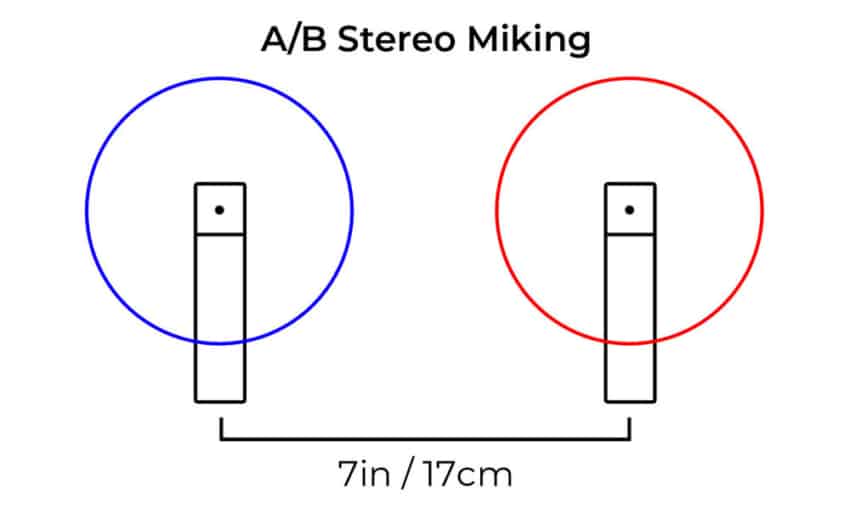
The A/B method, also known as “Spaced Pair”, involves two microphones positioned anywhere from 3 to 10 feet apart, meant to capture the same sound source.
The distance between them will create time-of-arrival (phase) and level (amplitude) differences in the input they receive which can be used to recreate location cues for out brain to use to locate sound sources, and it works really well when creating wide stereo images.
The main issue with this method is that it can create some serious phase issues, especially when listening back in mono.
Mid/Side
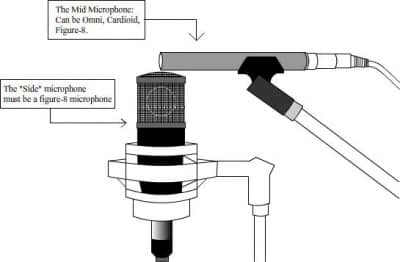
Mid/Side consists of using one cardioid and one bidirectional mic, or figure of 8 polar pattern, where the cardioid microphone is facing towards the sound source while the bidirectional mic is facing to the sides. Both microphones are generally stacked on top of each other to prevent phase issues.
The interesting thing about the mid/side technique is that is allows you to control how much vs how little of a stereo feel you want by increasing or lowering the bidirectional mic’s level, while the cardioid mic is still recording everything straight in front of it.
Examples of Stereo Microphones
It’s worth noting that you can use any two cardioid microphones together to record the same source, essentially creating a stereo recording, which is how X/Y and A/B work, even though some microphones already come with said mic configuration built-in (not A/B since the mics need to be far apart).
If you want to learn more about the ideal microphones to use in these cases, then check out this article I wrote about the best matched/stereo pair microphones.
Audio-Technica AT2022 (X/Y configuration)

The AT2022 is an X/Y condenser stereo microphone that features rotatable capsules that can point 90° to 120° from one another.
In the mix, the left capsule will be panned left while the right one will be panned right.
You can get the Audio-Technica AT2022 here:
- Audio-Technica AT2022: Amazon, Sweetwater.
Audio-Technica AT4050ST (Mid-Side, X/Y)
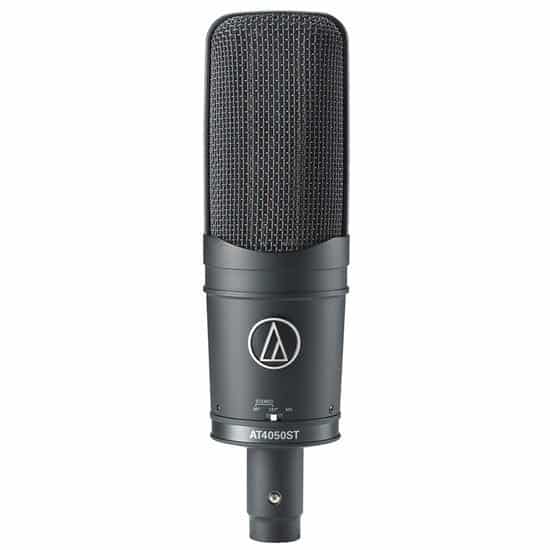
There are nearly no dedicated Mid-Side mics out there since the effect is generally achieved using a cardioid mic pointed directly at the source and a figure-8 mic in a 90° angled, facing the sides.
The AT4050ST is a Stereo mic that includes both the Mid-Side and X/Y (90° and 127°) modes, as well as a low-cut filter and a -10dB PAD.
A more affordable way to achieve the same effect would be to go with an AT2020 and an AT2050, set the AT2050 to figure-8 and record with both of them.
You can get the Audio-Technica AT4050ST here:
- Audio-Technica AT4050ST: Sweetwater.
Golden Age Project R1 ST (Blumlein configuration)

The Blumlein Technique involves the use of two figure-8 microphones arranged in a X/Y configuration, picking up sound all around the microphones.
The Golden Age Project R1 ST is a ribbon microphone that already comes with these two capsules built-in and essentially works in the Blumlein Configuration.
You can get the Golden Age Project R1 ST here:
- Golden Age Project R1 ST: Sweetwater.
Stereo USB Microphones
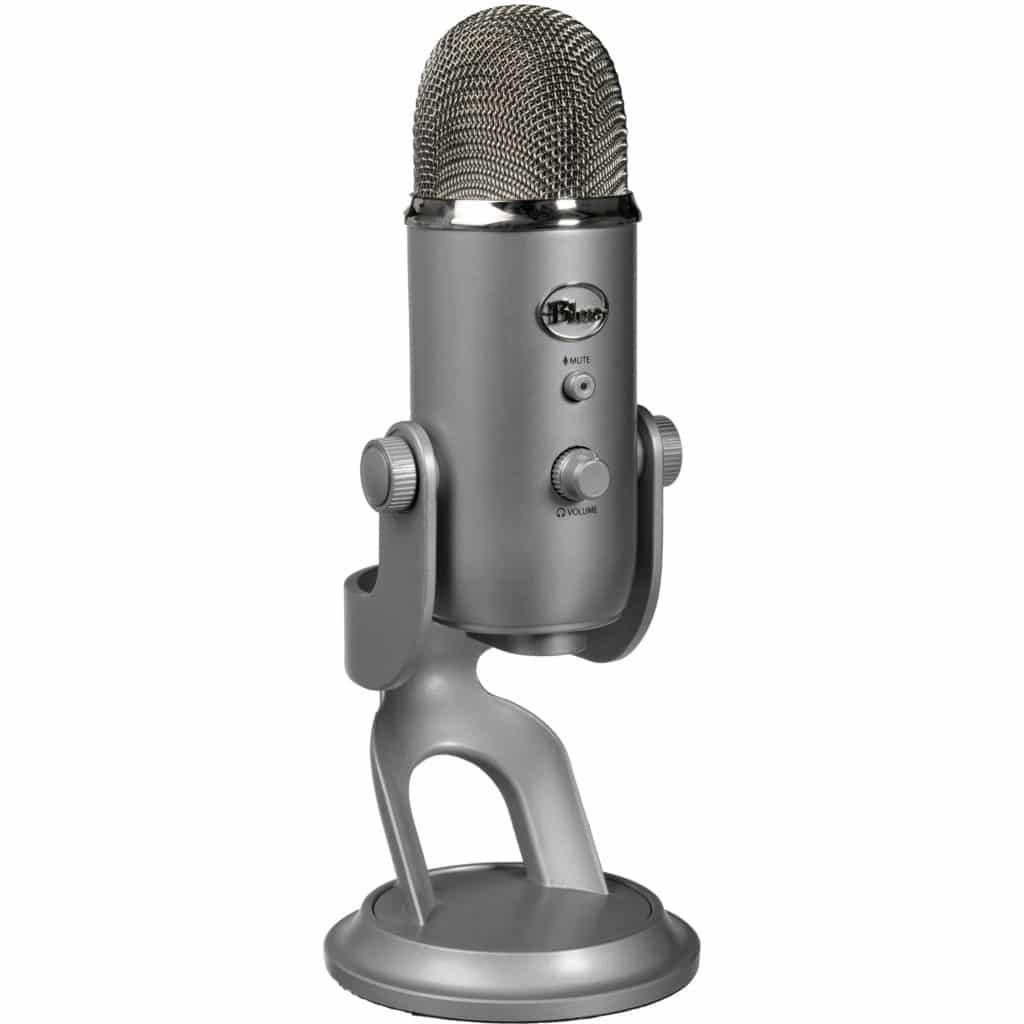
USB microphones are generally designed to cater to a vast audience, which means that only having a cardioid polar pattern may not be enough, and this is where multi-pattern USB microphones, such as the Blue Yeti and the HyperX Quadcast come in.
Both of these microphones are identical in every way except looks: They feature four polar patters, Cardioid, Omnidirectional, Bidirectional and Stereo, as well as zero-latency monitoring, a Gain Dial, a Headphone Volume Knob, and a Mute button.
When using the stereo setting, you should be able to hear the difference between the right and left channels, especially when listening on headphones, and this is a great polar pattern for musicians, especially for recording acoustic guitars.
I wrote a comparison between the Blue Yeti and the HyperX Quadcast that you can read here.
What cables do you need for XLR Stereo Microphones?
Regular XLR cables have 3 pins, one for the ground and two that carry the signal. However, with stereo microphones, since each capsule records its own mono signal, you need two additional signal wires per capsule.
Most stereo microphones use a 5-pin cable where Pin 1 is the ground/shield and the rest of the pins are there to carry the positive and negative polarities of the signals of each capsule. Let’s take a quick look at how this works:
- Pin 1: Common ground/shield.
- Pin 2: Mic capsule A signal (positive polarity).
- Pin 3: Mic capsule A signal (negative polarity).
- Pin 4: Mic capsule B signal (positive polarity).
- Pin 5: Mic capsule B signal (negative polarity).
If you own a regular stereo microphone, then a 5-pin XLR cable is what you need. Of course, check the manufacturer’s specifications to make sure.
Now, there is another set of microphones out there which have even more capsules built-in, and these are generally designed to record in a 360° (full surround recording capabilities). These are called Ambisonic Microphones.
What are Ambisonic Microphones?
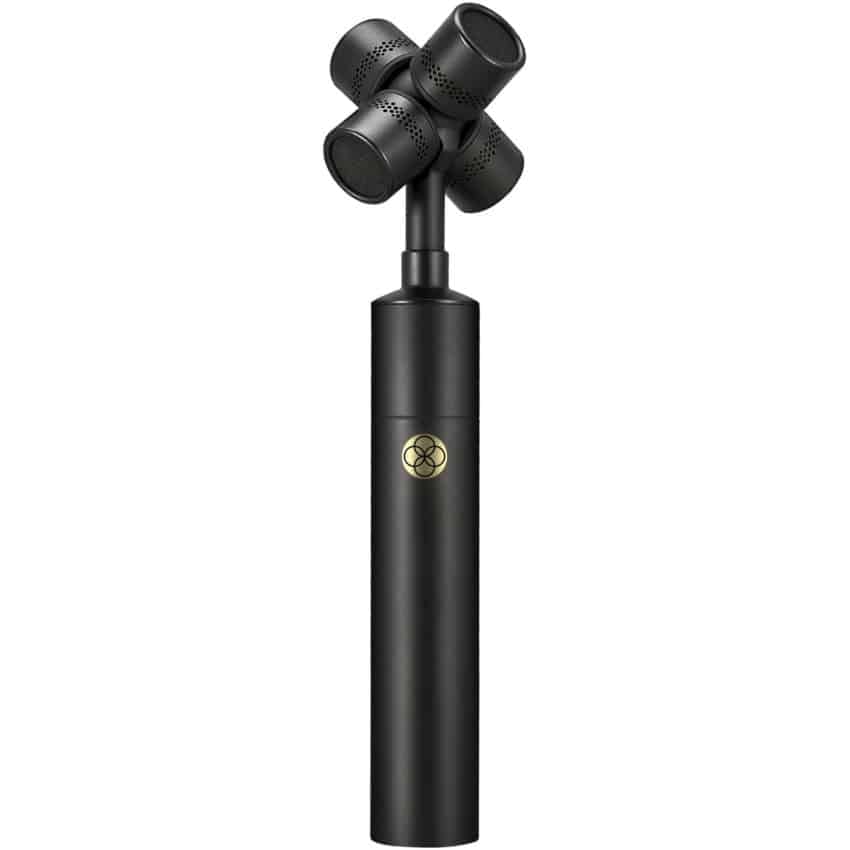
Ambisonic microphones capture sound by using not one, not two, but four (or sometimes even more) capsules and record everything in a 360° to capture sound in a full-sphere surround format.
Each capsule of these Ambisonic microphones also outputs its own signal, which is sent to its individual channel. Since each of the capsules outputs a mono signal, it’s only in the mixing phase where the combined signals yield an ambisonic sound.
Now, even though the most common type of ambisonic microphones only feature a total of 4 capsules, there are some that can house up to 8, and each of those capsules gets two pins (2 signal wires) in the connector.
Here’s how a 4-capsule ambisonic mic connection would look:
- Pin 1: Common ground/shield.
- Pin 2: Mic capsule A signal (positive polarity).
- Pin 3: Mic capsule A signal (negative polarity).
- Pin 4: Mic capsule B signal (positive polarity).
- Pin 5: Mic capsule B signal (negative polarity).
- Pin 6: Mic capsule C signal (positive polarity).
- Pin 7: Mic capsule C signal (negative polarity).
- Pin 8: Mic capsule D signal (positive polarity).
- Pin 9: Mic capsule D signal (negative polarity).
Conclusion
All microphones, be it mono or stereo, output a mono signal for each active capsule, which means that stereo microphones actually output “multiple mono” signals. Most stereo microphones only feature two capsules, which means that they only output two mono signals, however, ambisonic microphones can have up to 8 capsules and output 8 mono signals.
Most people don’t really require ambisonic microphones to be honest. However, stereo recording techniques definitely have their place and you should absolutely consider learning how to produce music using said techniques.
However, do you really need a Stereo microphone, or can you use two mono mics? In most cases, you won’t need a dedicated stereo mic since getting two pencil condenser microphones will let you record in X/Y and A/B and achieve fantastic results.
Also, I’d highly recommend trying out the Mid-Side technique since the stereo width it creates is absolutely fantastic!.
